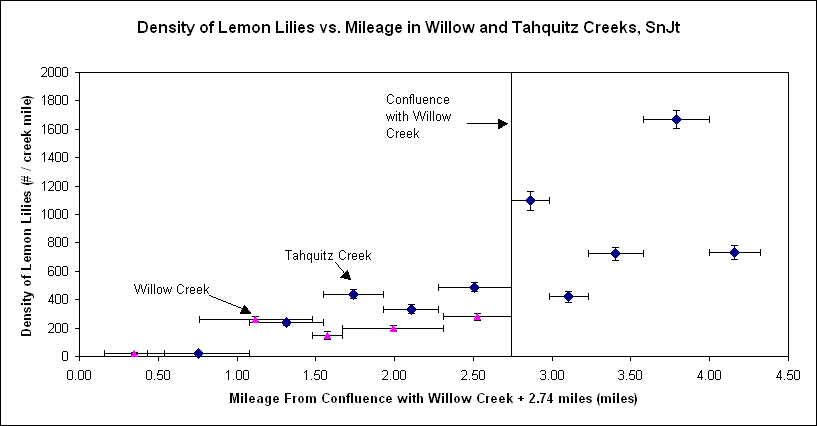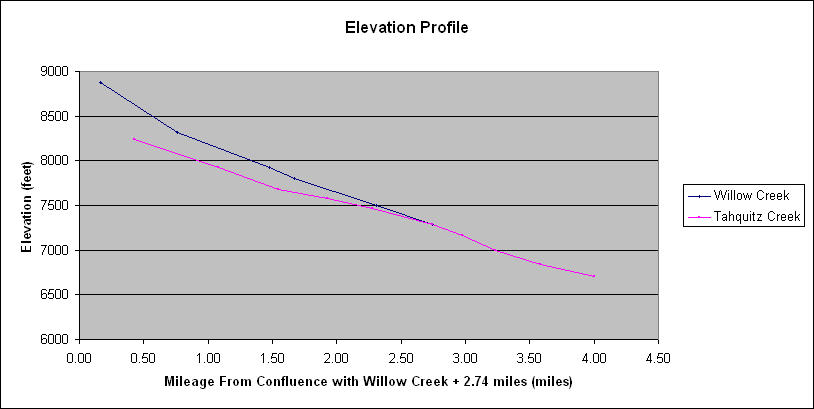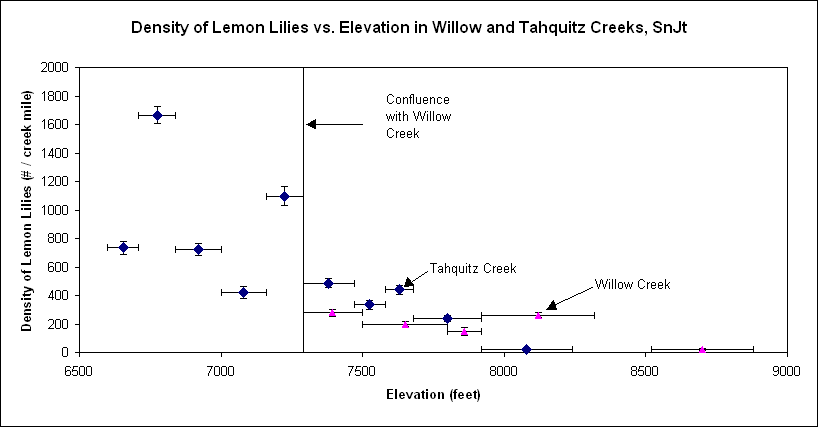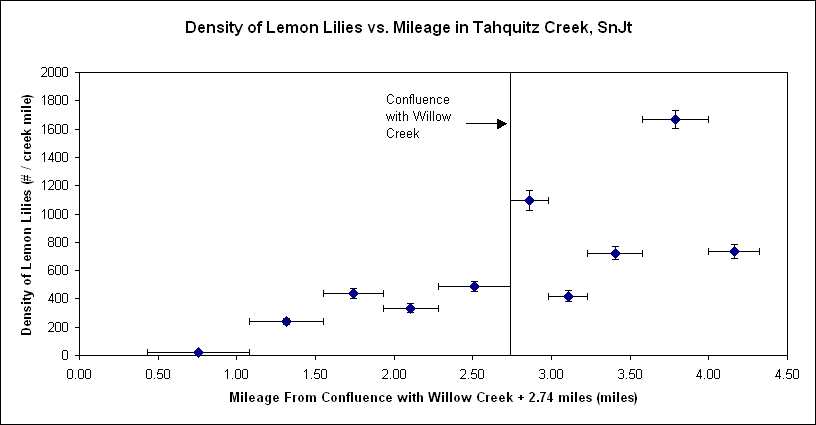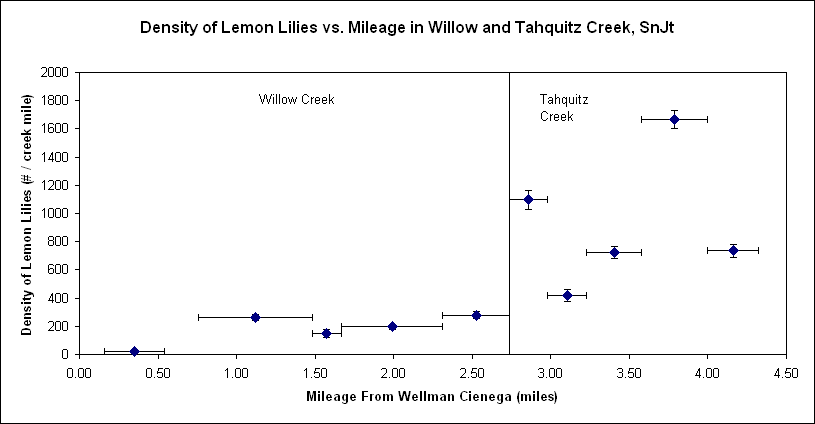Lemon Lily Census of Willow and Tahquitz Creeks, 2009
Dave Stith and Tom Chester
This is an incomplete draft of this page
Introduction
Lemon Lily or Parry's Lily, Lilium parryi, was first described in 1876 by Dr. Charles Christopher Parry, a botanist with the Pacific Railway Survey for whom it is named. This member of the Lily Family Liliaceae is a perennial herb which grows from a bulb with a stem reaching a height of 1.9 meters. It has scattered or whorled leaves with very fragrant lemon-yellow funnel shaped flowers. In Southern California it grows in the San Gabriel, San Bernardino, and San Jacinto Mountains as well as Palomar Mountain. Small populations can also be found in southeastern Arizona in the Santa Rita, Huachuca, and Chiricahua Mountains and in extreme northern Sonora, Mexico in the Sierra los Ajos. They inhabit springs, seeps, wet meadows, and shady canyon bottoms along perennial streams at an elevation of 4,000 to 9,000 feet. Three populations in Arizona have been severely impacted by fire and subsequent erosion; and a fourth by mining activity (Arizona Game and Fish Department, 2001). In California their populations have been negatively impacted by "flower pullers" in Palomar (Craig H. Reiser, 1994) and bulb collectors in San Jacinto (H.M.Hall, 1902). It is uncommon throughout its California range and close to extirpation in San Diego County (Craig H. Reiser, 1994) and is listed by state and federal agencies as a sensitive species that should be protected.
We decided to embark upon this endeavor after reading Harvey Monroe Hall's 1902 "Botanical Survey of the San Jacintos." Hall wrote in this flora:
This lily, with its tall erect stems and conspicuous flowers either clear yellow or peppered with black, is a great favorite with the tourists and campers that annually visit the mountain.
We were familiar with Lemon Lilies from our botanical hikes in the San Jacintos but found only small numbers in a few sporadic locations, and they seemed to be conspicuously absent in locations where we thought they ought to occur. Then came a shocking statement. Hall continued, "It was only a few years ago that the showy blossoms were frequently met with along all the streams and bogs from nearly the lower edge of the Transition Zone up to an altitude of 9000 ft., thus reaching into the lower part of the Canadian Zone. While it is now by no means rare, still it is found in profusion only on the more remote parts of the mountain. That this is due entirely to the diligence of the bulb hunters is difficult to believe, and yet one party took over 5000 bulbs in a single season. Perhaps this, in addition to several consecutive dry summers, is responsible for the rapid depletion of their numbers." We were astonished. Were they really once that abundant, and if so, what happened to them?
We began talking about Lemon Lilies on our hikes together. Clearly their numbers have not recovered in over 100 years. Other than the showy flowers, we could not recall seeing any signs of reproduction such as fruit, seeds, or seedlings. We feared that those that remained were "the living dead" and were on the verge of extinction in the San Jacintos. After doing some quick research on the Internet it seemed they faced insurmountable odds. Removal of the bulbs results in extirpation. Their seeds may remain viable for only one or two years (Newman, 1990 as cited in Mistretta and Parra-Szijj, 1991), so there is no seed bank waiting for that "rainy day"(Mistretta and Parra-Szijj, 1989). Their habitat is declining. The water they need in the meadows has been reduced due to the effects of grazing, and water in the streams has been taken for consumption by an ever-growing local human population. Their reduced numbers leave them even more vulnerable. We frequently see lilies that have been eaten by deer. A fixed number lost to predation each season is much more devastating in a small population than in a larger one. They are pollinated by two species of moths (Hyles lineata and Hyles perelegans). Populations may get visited less often and/or by fewer pollinators when they are isolated, and loss of the specific pollinator could result in reproductive collapse. Finally, the pine forest in which they live has ascended 100 feet in elevation in the last decades due to warming (A. Kelly, 2008).
We chose Willow Creek and Tahquitz Creek as our survey sites. On our Plant Trail Guide surveys we had seen Lemon Lilies at Wellmans Cienega at the top of Willow Creek and at Caramba where Tahquitz Creek precipitously falls off the mountain into the desert below. Willow Creek is a permanent water source and Tahquitz Creek includes a number of meadows. Surely, if we were to find Lemon Lilies, it would be along this course. Tahquitz Creek, below the confluence with Willow Creek, had the added appeal of being an underbotanized area. This is not without good reason. It is a very hazardous location of steep cliffs, large boulders, slick rocks, and willow thickets.
Method
The survey was conducted on approximately every fourth day from July, 28 to October, 1, 2009 and included x# of trips. Time allotted for botany varied for each trip and ranged from x# to y# of hours resulting in z# hours of total botanizing time. The number of miles surveyed varied from x to y miles per trip for a total of z miles. The elevation ranged from 8800 feet near Wellman's Cienega to 6560 feet at Caramba. Both authors were present for each trip, and on many occasions there were also one or more of our colleagues present (see acknowledgements).
The study area was traversed entirely on foot. The survey was conducted from the best available vantage point for any given location. Every attempt was made to search from within the stream bed whenever possible, while some surveys had to be conducted from the stream bank. On occasion a section of creek had to be bypassed because of impenetrable willow thickets, impassable waterfalls and rock formations, or large pools of water. No attempt was made to quantify this distance, but we strongly believe it is negligible at less than x% of the study area.
Every Lemon Lily encountered was counted regardless of maturity. For our purpose of conducting a visual survey without taking any collections of plants, we considered every stem to be a separate individual. The counts were tallied in one of three ways. First, the author crisscrossed the creek searching all areas for Lemon Lilies and counted them. Second, our colleagues assisted in locating areas of Lemon Lilies and pointed them out for the author to count. Finally, our colleagues assisted in locating Lemon Lilies and counted them for the author.
A GPS device was used to aid in two very important aspects of the survey. First, GPS was used to define discreet sections of the study area. Periodic locations along the survey route were selected to be recorded and tallies of Lemon Lilies were made between these points. Second, GPS data was used to ensure that no sections of the study area were missed. A GPS track was made for each trip and the entry and exit points were mapped. Most often, on consecutive trips, data collection resumed at the previous exit point. On occasion, due to the proximity of a trail to an entry point, we deviated from this sequence of events, so that some data do not appear contiguous.
Results
